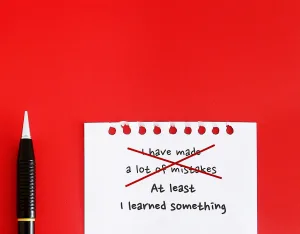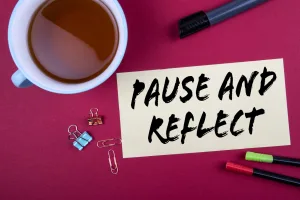EMBRACE THE COUNTER-INTUITIVE

Discover how doing less and thinking differently can be your most powerful executive advantage!
In a world that constantly demands more from our brains – more speed, more focus, more innovation – it’s easy to fall into conventional traps of productivity. We push harder, try to do more, and rarely stop to question if our most ingrained thinking habits are truly serving us. But what if the secret to unlocking your brain’s true brilliance lies in embracing the counterintuitive?
This month’s ‘Brighter Thinking Tip’ delves into some surprising, often overlooked strategies that might just revolutionise how you approach work, creativity, and mental clarity. Prepare to challenge your assumptions and discover how doing less, thinking differently, or simply acknowledging what’s already done, can be your most powerful executive advantage.
The Power of Strategic Boredom: Why Doing Nothing is Your Brain’s Best Friend
In our hyper-connected world, the very idea of boredom feels almost anachronistic, doesn’t it? Yet, for leaders aiming for peak brain efficiency, embracing strategic boredom might just be your most potent secret weapon. Our brains are constantly bombarded with information, from back-to-back meetings to endless notifications. While we often view downtime as unproductive, constant stimulation actually depletes our cognitive reserves and stifles our most brilliant ideas.
Neuroscience points to the “Default Mode Network” (DMN) – a specific brain network that activates when our minds are at rest or wandering. This isn’t laziness; it’s a powerhouse for creativity, self-reflection, and problem-solving. It’s during these moments of ‘doing nothing’ – staring out a window, a quiet walk without your phone, or simply letting your mind drift during a mundane task – that disparate ideas connect, insights emerge, and learning consolidates. Instead of trying to fill every spare moment, intentionally schedule “brain downtime.” Treat it with the same reverence as a strategic meeting. By giving your brain the space to breathe and wander, you’ll find it returns sharper, more innovative, and surprisingly more productive. Yay!

Thinking in Metaphors: How Figurative Language Sharpens Your Strategic Acumen
We often associate metaphors with poets and English lessons, but what if they were a crucial tool for executive brilliance? Thinking in metaphors is far more than just poetic flair; it’s a powerful cognitive hack that can dramatically enhance your strategic clarity, develop innovation, and make your communication incredibly compelling. Our brains are wired to understand the world through comparisons and analogies. When you frame a complex business challenge as, say, “navigating uncharted waters” or “building a bridge to the future,” you’re not just using fancy words. You’re activating different neural pathways, simplifying intricate concepts, and helping both yourself and others grasp the essence of a situation instantly.
The tip here is to consciously cultivate a “metaphorical mindset.” When faced with a perplexing problem, ask yourself: “What is this like?” Or when explaining a new strategy: “What familiar concept can this be compared to?” This practice forces you to distil complex information into memorable, relatable images, making your insights stickier and more persuasive. It’s a subtle but profound shift in thinking that can generate new solutions and enhance your leadership influence.
Welcome to the “Reverse To-Do List”: Unlock Hidden Productivity by Acknowledging What’s Already Done

We’re all familiar with the endless to-do list – a relentless reminder of what still needs accomplishing. But what if the key to consistent motivation and greater productivity lies not in what you plan to do, but in what you’ve already achieved? Welcome to the concept of the “Reverse To-Do List.” Instead of writing down tasks you need to complete, you list the tasks you’ve already finished! You could do this throughout the day or week. Woo-hoo!
This might sound counter-intuitive, but the psychological benefits are immense. Our brains thrive on progress and positive reinforcement. Constantly staring at uncompleted tasks can feel overwhelming and demotivating. By visually tracking your accomplishments, no matter how small – “Responded to 10 emails,” “Had that difficult conversation,” “Finalised the Q3 report” – you’re actively programming your brain for success. This practice combats overwhelm, builds powerful momentum, and shifts your focus from deficits to achievements. It’s a simple, yet profoundly effective, way to leverage your brain’s reward system, reduce mental fatigue, and fuel sustained motivation. Give it a go; you might be surprised by how much you’re actually getting done.
Embrace the “Good Enough” Brain: When Perfectionism Kills Progress

For many high-achieving executives, the pursuit of perfection is deeply ingrained. We believe that only by striving for flawlessness can we truly excel. However, this relentless drive for ‘perfect’ often comes at a significant cognitive cost, ironically hindering the very progress and efficiency desired. Our brains, when constantly aiming for an impossible ideal, can fall prey to analysis paralysis, decision fatigue, and burnout. We expend vast amounts of mental energy on marginal gains that often yield diminishing returns, while truly important initiatives gather dust.
This tip encourages you to consciously embrace the concept of the “good enough” brain. This isn’t about lowering standards or becoming complacent; it’s about strategic allocation of your most precious resource – your cognitive energy. Understand that your brain’s capacity to labour over every minute detail is finite. Learn to identify areas where “good enough” is truly sufficient. This will free up your mental horsepower for tasks that genuinely demand absolute excellence and innovative thought. By consciously choosing to ‘satisfice’ in certain domains, you’ll reduce mental friction, accelerate decision-making, and create more space for high-impact work. This ultimately leads to greater overall output and a healthier mindset. Phew!

“The opposite of a good idea can still be a good idea!”
– Rory Sutherland
Vice-Chairman, Ogilvy and Mather Group
I trust these tips encourage you to think differently, and to THINK BRIGHTER! Let me know how you get on testing them.


